Champaign County Courthouse
The story of the Courthouse begins in 1833 when Champaign County was formed with Urbana as
the county seat. The first courthouse, a log cabin, was so crude it saw only two sessions
of court in 1836 and 1837. It was replaced in 1840 with a brick and wood frame building
that served for the next 9 years. It was in this building that Abraham Lincoln appeared
as a lawyer while riding the circuit.
The third Champaign County Courthouse was constructed in 1848 by E.O. Smith of Decatur in
Macon County for a cost of almost $3000. North-facing at the center of the public town
square it was a monument to justice, complete with brick and wood construction and a
looming bell-tower on the center of its roof. The surrounding property remained unfenced
and locals noted a fair number of local animals pasturing on the property, as was not
uncommon for the time period. Abraham Lincoln again served in this building and was in
Urbana when he learned of the passage of the Kansas-Nebraska Act, gave a speech in
opposition to the spread of slavery in the territories and learned of receiving votes at
the Republican Convention in Boston. Mr. Lincoln left a substantial legacy in Champaign
County.
The year 1860 saw a $30,000 remodeling of the courthouse to a steel frame with a masonry
exterior. This project was initiated by the County Board in spite of the growth west of
the city and the incorporation of Champaign. The project even included the creation of a
horse-drawn railway from the Doane House near the depot in Champaign to the courthouse in
Urbana to ensure the county seat would remain where it was originally located. In 1883,
the Seth Thomas clock was installed in the third County Courthouse with the advent of
National Standard Time.
In 1901 a new courthouse designed by noted architect Joseph Royer was dedicated. From its
balconies one could see miles over fertile Champaign County fields. Unfortunately, this
tower was struck by lightning at least four times including in 1930 resulting in the loss
of the clock tower spire and again in 1952 removing the belfry and shortening the tower by
nearly 60 feet to its present squat castle-like appearance at only 85 feet.
Recently, as noted by the third image, the bell tower and outer edifice was remodeled to
restore the courthouse to the 1901 appearance.
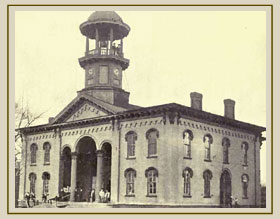
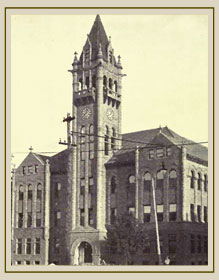
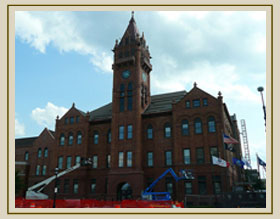
Christian County Courthouse
The first Christian County courthouse was constructed by an agreement between the
Commissioners' Court of the County (Called Dane County at that time. It was ordered
that a suitable courthouse structure be constructed on the town square and the task was
contracted in 1839 to two men, Jesse Elgan and Marvellous Eastham. The cost was a little
over $2000 and the building was finished in the following year of 1840.
The original courthouse was sold at auction for $276 when the new courthouse was
constructed in 1856. It was subsequently moved several times, including the county
fairgrounds for use as an office, then as storage, before finding its way to the
Christian County Historical Complex at Illinois 29 and 48 on Morrison Drive, where
continued preservation is taking place.
From 1856 until 1902, the second county courthouse was used, even though the second
floor had only one courtroom. In the early stages, the construction was rife with
delays and litigations, so much so that attorney Abraham Lincoln represented the
County, in the appeal, when contractors sued the city for failure to pay for the
construction that had already taken place. The case eventually went to the Illinois
State Supreme Court.
The 1902 courthouse is the county's third.
Up until 1853, it was the last stop on Abraham Lincoln's 8th Judicial Circuit route,
other wise known as the "Mud Circuit," and where Lincoln reportedly issued a "writ
of quietus" to silence the sound of hogs that were disrupting a trial.
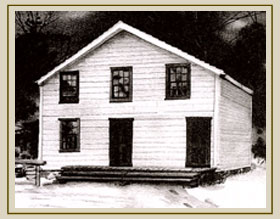
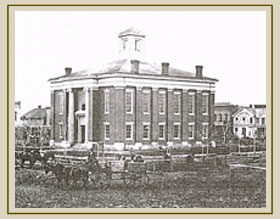
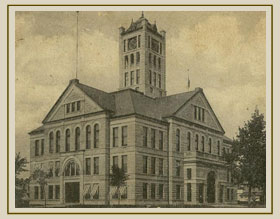
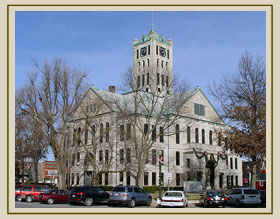
DeWitt County Courthouse
For nearly a decade from 1839 to 1849, the DeWitt courthouse was a simple wood-frame
building on the square in Clinton. Consisting of one story and boasting a meager 20
feet by 36 feet in its single room, this was not merely the location of the court,
but also of community gathering ranging from church groups to dances. It lasted until
destroyed, following the completion of a new courthouse in 1849.
The 1849 courthouse was, though much more modern than the previous, still a bit
lackluster, in spite of its being a marked improvement. This new design opted for
simplicity and functionality. Built for $ 3,565, with $1000 coming from local donations,
the new courthouse was brick in construction and boasted two-stories with a space
measuring thirty-two by forty-two feet. This courthouse lasted until a new one was
constructed in 1893.
The current courthouse is imaged at the right on the bottom, beneath the two images of
the second courthouse..
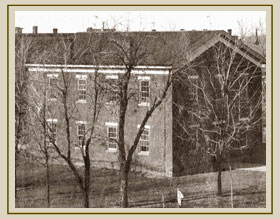
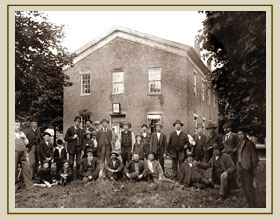
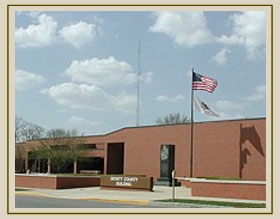
Edgar County Courthouse
Edgar County's first courthouse was a meager wooden structure, traditional to the
period and had hardly more than one room for the entire courroom. Built in1825 for
around $690, it was placed in the center of the square. Costing a staggering $4250
in 1832, the second courthouse was a two-story, brick courthouse with a domed, glass
cupola was erected in the middle of town on the square by contractor Leander
Munsell-who would later go on to build courthouses throughout the state.
Both Abraham Lincoln and Stephen Douglas spoke at the second courthouse, as they passed
through Paris on separate occasions. One case that Lincoln argued there was Benson v.
Mayo. In 1885, the courthouse was condemned.
Eventually the county decided to build a third courthouse. After choosing a design by
architect Henry Elliot, the building committee made two contracts that together cost.
Construction began in 1891for $104, 807 on the third courthouse which stands today.
Finished in 1893, this courthouse boasts a four-faced clock tower rising 150 feet into
the air. On top of the tower is a female figure holding the scales of justice in one
hand and facing west, because at the time, the hope of the country was to the west.
Over the years the scales have occasionally blown out of her hand, and the county would
have someone eventually climb up to put them back. However, the liability risked by such
a dangerous task required a new solution and the last time the scales were replaced,
they were carefully lowered onto the statue's hand by helicopter.
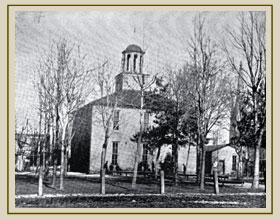
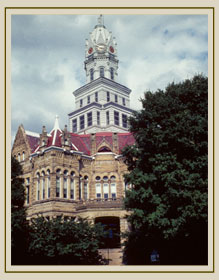
Livingston County Courthouse
The Livingston County courthouse was constructed for $800 after the County
Commissioners contracted construction in 1839. The original courthouse was
a strictly utilitarian design of a simple wood frame that measured twenty by
thirty feet and rose two stories into the air. It was, aside from being
home to the judicial events of the day, used as a meeting place for the
community and the local churches, debating societies, political meetings,
and even housed the local school. In the end, it became more of a multipurpose
building that, as most courthouses did, became the center of the community.
The county even rented rooms in the courthouse for anywhere from two to three
dollars per month when the court was not in session.
In 1856, a newer courthouse (the second in Pontiac) was built and the old
courthouse was used primarily as a schoolhouse.
Construction on the present-day courthouse, the county's third, began in late
1874 and was completed late the next year. The courthouse was built after fire
consumed the second Livingston County Courthouse on July 4, 1874. The courthouse
was designed by architect J.C. Cochrane, who was one of the designers of the
"Old State Capitol". The courthouse is in a Second Empire style. It is well
maintain and was listed on the National Register of Historic Places in 1986.
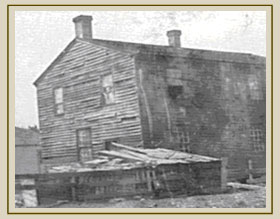
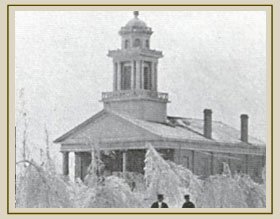
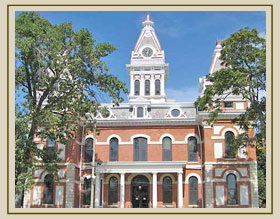
Logan County Courthouse
Postville
Constructed in 1840, the original building (until 1848) was one of the courts in
which Abraham Lincoln argued cases while traveling the historic Eighth Judicial
Circuit. Long after being converted to residential use, the original courthouse
was purchased by Henry Ford and in 1929 moved to his Dearborn, Michigan,
Greenfield Village museum. The grounds currently display a replica that was
constructed in 1953 on the original site as part of the city of Lincoln's
centennial celebration; it is run by the Illinois Historic Preservation Agency.
Mt. Pulaski
The second courthouse was erected in 1848, when Mt. Pulaski became the county
seat and this building is still intact today and is managed by the Illinois
Historic Preservation agency. This Greek Revival courthouse stood as the seat
of government until 1855 and is one of the few remaining original structures
of the Eighth Judicial Circuit and one of only two courthouses remaining in
their location, as Lincoln would have seen them.
Lincoln
When Lincoln, Illinois, became the county seat of Logan County in 1856, court
did not resume at the Postville Courthouse. Instead, a new courthouse was
constructed on the site of the present Logan County Courthouse. The 1856
structure burned April 15, 1857, and was replaced by a courthouse that served
until 1903, when construction on the present courthouse began and was finished
in 1905. Abraham Lincoln worked in both the 1856 and 1858 courthouses, as well
as in the Postville and Mt. Pulaski courthouses.
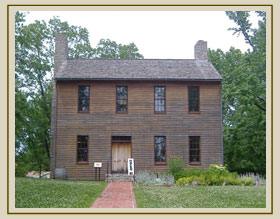
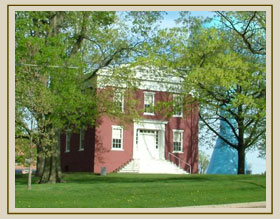
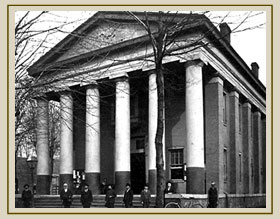
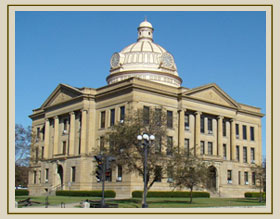
Macon County Courthouse
In 1838, Court was still being held in the log building that was under construction
on the square when the Lincoln's arrived in 1830. The reconstructed log courthouse
now stands at the Macon County Historical Museum. The building was an eighteen by
twenty-four foot one and a half story building that had a door on the north and one
on the south, with but a single room on each floor, which was heated by a single
fireplace. When it was sold following the construction of the second courthouse,
it was purchased by a local farmer, moved and then used as a house and then a barn.
In March of 1837 Leonides Munsell of Paris was selected to build the new brick
courthouse. The contract specified that it was to "be equal to or superior to the
McLean County courthouse." In fact Munsell built the courthouse in Bloomington in
1836 after building the courthouses of Paris and Shelbyville in 1832 and Charleston
in 1835. All of them were made of brick and of the coffee mill construction, square
with a cupola in the center. The Macon County courthouse was 32 feet square and was
built at a cost of $10,000. The first floor was offices with the courtroom on the
second floor.
It is believed that Lincoln appeared for the last Circuit court session held in the
log building, as the new brick courthouse across the corner was nearing completion when
Lincoln arrived, but was running behind schedule and had not yet been completed.
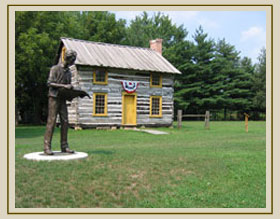
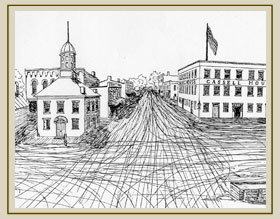
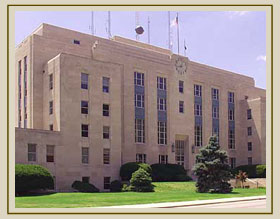
Mason County Courthouse
Though only on the Eighth Judicial Circuit for about four years, this stop on the circuit
was the county seat, as well, for roughly that amount of time. In April of 1841, voters
in Mason County elected their officials for the first time, as the county had only been
formed that January from parts of Tazewell and Menard Counties. The county seat at that
time, as had been designated by the Illinois State Legislature and approved by the
governor, was that the county seat rested in Havana, Illinois. This law saw that Mason
County residents were to meet at Havana on the first Monday in April, 1841, and proceeded
to elect a sheriff, treasurer, and other county officers.
Throughout this and all votes and politicking of the time, there were allegations on all
sides of rigging, cheating, and crimes involving the votes and from this an air of
hostility would cloud the county, when Havana was the victor. In fact, one story recounts
that upon discussion of the mill who would supply the timber for the courthouse, open
hostilities broke out and the mill was burned to the ground. The following May term of
court was held at Havana at the hotel of Major Ossian M. Ross, beginning November 12, 1841,
and while terrible snow storm prevailed at the time, Samuel H. Treat was the presiding
judge and court was held regardless.
Agitation between the two towns continued and on January 19, 1843 permission from the
Illinois State Legislature was given to hold a special county-wide vote where Bath the
received a majority of votes and was declared the county seat. Its inhabitants soon had
the satisfaction of seeing the archives of the county removed to their town. The June term
of the Circuit Court for 1844 was held at Bath, the previous June term having been held at
Havana, though currently taking place out of the home of one Colonel West.
Bath continued the county seat for eight years, but when the seat changed, the courthouse
(which cost an estimated $8000) was converted into a school. On February, 1851, legislation
was obtained by which another election was held on the second Monday of March, 1851, at
which the question was again brought before the people. The clerks of election opened two
columns, one "For Havana" and one "Against Removal." The election resulted in again making
Havana the county seat, which it has since continued to be. The last term of Circuit Court
held at Bath was in November, 1850.
In 1851, Mason County built the current courthouse, though it has undergone to many
remodels and upgrades to be even recognizable as the original structure.
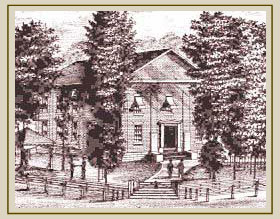
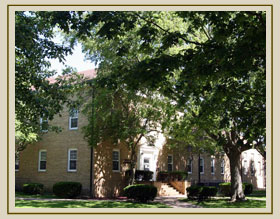
McLean County Courthouse
The site of the McLean County History Museum was home to three previous courthouses
before the one that houses the museum was built in 1900. The first courthouse at the
site was built in 1832 and no images remain today.
Second courthouse was built in 1836 by Leander Munsell, who had also designed and
built the Edgar County Courthouse, was contracted by the McLean County
Commissioners to design and build the McLean County Courthouse. He built it in
his very signature style, as noted in the image, when compared to the Edgar County
Courthouse image, for a cost of $8500. This building was demolished in 1868, in
order to create a more modern building.
The third McLean County Courthouse was begun in 1868 and was designed in the French Renaissance style by the supervising architect, Alfred Piquenard, who oversaw the construction of the David Davis Mansion a few years later. Piquenard was also the supervising architect for the Illinois statehouse in Springfield, which is still standing today. Piquenard unfortunately died in 1876 before the Illinois statehouse was finished and his beautiful structure was lost to a fire in 1900.
The fourth McLean County Courthouse, which replaced the third courthouse, housed the McLean County Circuit Court from 1900-1976. The building itself was designed by William Reeves and John M. Baillie of the Peoria firm Reeves and Bailey. The original construction was completed in 1900 at a cost of $461,640. Shortly after its completion, a fire destroyed many of the buildings in the square and the courthouse. The courthouse was rebuilt in 1903, just as it appeared before, following the fire.
In the 1980s the McLean County Historical Society moved to put its museum in the Old
Courthouse. Today the museum operates out of the courthouse building as it has since 1990.
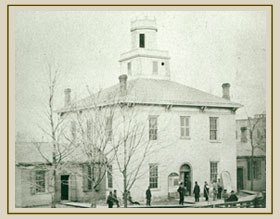
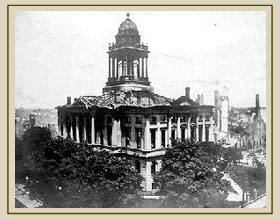
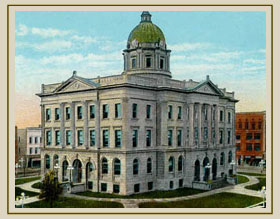
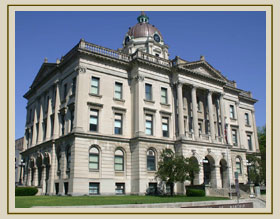
Menard County Courthouse
Between 1843 and 1844, the Menard County Commissioners were delighted to have their
new two-story Greek Revival courthouse built for a total sum of $6,640. Featuring a
n additional one-story white cupola on the front supported by an all-brick face on
the structure, this new courthouse would last until 1896; when it would be demolished
to make room for a new courthouse.
For nearly four years since the county seat was named, all court activities had been
handled at the Grinsley and Levering store. About the time the court house was built,
a jail was erected, at a cost of $300. In1870, less than thirty years later, a new
jail was put up which cost about $22,000.
This particular structure bore a very common appearance with several of the other
structures of the Eighth Judicial Circuit and is a noticeable style that was described
by locals as of an old Kentucky tobacco-barn style.
In 1896/1897 the old courthouse was torn away and the new building, which stands today,
was erected.
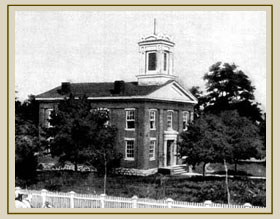
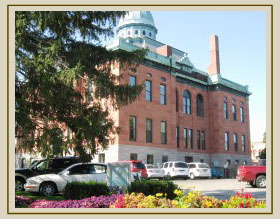
Moultire County Courthouse
The first session of court in Moultrie County was held at the residence of James
Camfield. Although the county seat was set in Sullivan in 1845, the building of
the first court-house did not begin until the spring of 1847. Instead, court
was held in the schoolhouse in Sullivan. A local named Andrew Scott was the chosen
contractor for what was decided by the County Commissioners to be a brick structure,
thirty-eight feet square, and two stories high. Arranged with a hall passing
through the center on the ground floor, with two offices on either side, a jail
cell was cut off in the north-east corner of the basement floor. On the second
floor would be occupied wholly as a court room.
The entire cost of the building was $2,800 and it was completed in the spring of
1848. It was destroyed by fire in the summer of 1864, and nearly all the records
of the county were completely lost.
In 1865, construction was begun on a new courthouse, to be erected at the same
location. The stone for the foundation was shipped from Joliet and it was fifty
feet square, and thirty feet from the foundation to the eaves. From the eaves to
the dome, it was about thirty-eight feet, making the height from the foundation
to the dome sixty-eight feet.
The contract for building it was $18,000, but when it was completed it cost over
$21,000. "Uncle" Sammy Wright, and William Hayden hauled all the material for
building from Mattoon, except the brick. In 1866, when the building was finished
that summer, locals made certain that a fire-proof vault had been installed this
time.
The current courthouse was erected in 1904 on the same spot as the first two.
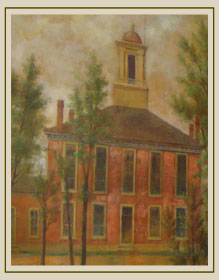
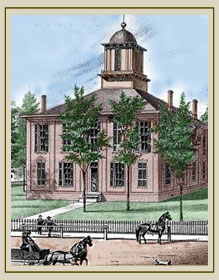
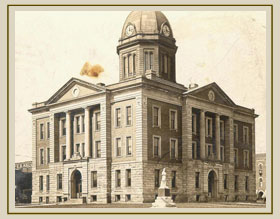
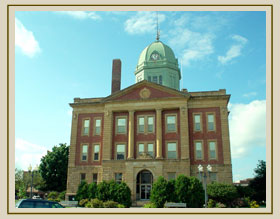
Piatt County Courthouse
The first courthouse owned by Piatt County was begun in 1843 by Judge Rickets, on the
site of the present courthouse. Finished in 1846 by Judge Ricketts was, at that time, a
Monticello carpenter and only later became the judge to oversee cases in that very same
building. Judge Rickets had ordered in 1856 that a new courthouse be erected on the old
site, once the old courthouse had been relocated. The original, small, wooden courthouse,
after being moved to the west side of the square to make room for the new courthouse, was
destroyed in a fire in 1885.
The second courthouse was built at a cost of $10,936 and was a fifty by sixty-five foot
brick structure, which included a first floor for county officials and two smaller
adjoining rooms on the second floor. This courthouse lasted for a fair number of years
before it was severely damaged by storms which tore off the cupola and a portion of the
gable end and roof of the building. At this point, the citizens of Piatt County felt that
a new building was absolutely necessary. In addition, it had become inadequate for the needs
of county business, as the county had grown.
In a September meeting in 1902 of the Piatt County Board, William L. Plunk of Sangamon
Township proposed a motion to submit to the people, at the next general election, a
proposition to issue county bonds for $100,000, for the purpose of erecting a courthouse not
to cost over $75,000, and to make necessary repairs upon the jail at a cost not to exceed
$25,000.
In 1903, the plans which had been prepared by Joseph W. Royer, of Urbana, were accepted
and the architect was instructed to prepare plans and specifications upon which the contract
was let July 8, 1903, to H. B. Walters of Danville for $75,000, with the stipulation that
the building be completed by July 15, 1904.
The old courthouse was sold at public auction and was bought by Lodge Bros. for $138.01,
which included the heating plant and the plumbing. The building was entirely removed by the
first of August of that same year. The corner stone of the new building was laid on September
22, 1903 and the new courthouse was occupied by the county officials in January of 1905.
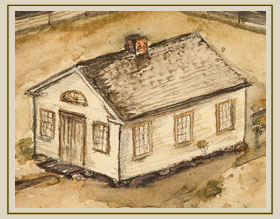
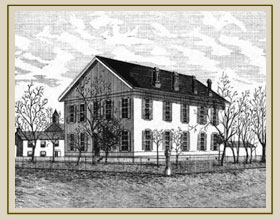
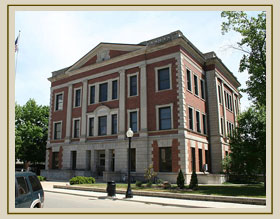
Sangamon County Courthouse
On April 10, 1821, the Sangamon County Commissioners entered into a contract with John
Kelley for $42.50 to build the first Sangamon County Courthouse. The specifics were
that the logs were to be 20 feet long, the house one story high, plank floor, a good
cabin roof, a door and a window cut out; the work to be completed by May 1st, of 1822.
The first proceeding was held there on June 4th and Kelley was paid $42.50 and $5.00
for "extras."
In 1830, the county ordered that a second, brick courthouse be built near the middle
of the square and it was completed in 1831 at a cost of $6,841.00. It was a two-story
square, brick building, with a hip roof, and cupalo on top, similar to the court houses
of the area from that period. In 1831, the old court house and the lot were sold to John
B. Moffett for $626.00.
Before long, in 1845, when a lot on the southeast corner of Sixth and Washington streets
was purchased for roughly $6000 by the county and another brick courthouse, with stone
portico and trimmings, was built, by order of county officials. This immense and
picturesque structure of Doric architecture occupied the half block on the east side of
the square. The building cost $9,680 and was used by the county from 1845 to January,
1876, when the State moved its offices to the present State capitol and vacated the public
square, which had been returned to the county in 1869, nearly seven years before. The
county then moved into the present building, and the court house was demolished and the
lots were sold off in 1877.
From 1876 until 1966, the Old State Capitol was the Sangamon County Courthouse. During
this time the building was extensively altered. In 1839, a two-floor building had been
large enough to hold the entire governmental structure of Illinois; but n 1898-99 Sangamon
County jacked up the historic structure 11 feet, added a third floor underneath it, and
tore out and rebuilt the interior to hold circuit court rooms and office space, in order
to accommodate the growth of the area.
In the early 1960s, the the city had also found the need to build a newer county building
and there was some interest from the city in historic revitalization, so the county ceded
the Old State Capitol to the state of Illinois and the state immediately went to work.
Areas of the Old State Capitol were reconstructed to resemble the appearance of the building
in 1860, as Lincoln would have seen it and they also dug out the plaza underneath and around
the Old State Capitol and built extensive office space underneath it. The reconstruction
work was carried out in 1966-69, and the rebuilt House Chamber was available for the state's
Constitutional Convention to use in 1970. Nearly forty years after that, in February 2007
then-U.S. Senator Barack Obama officially announced his candidacy at this location for
President of the United States, and in August 2008 he formally introduced his vice-presidential
candidate, Joe Biden, with the building as a backdrop.
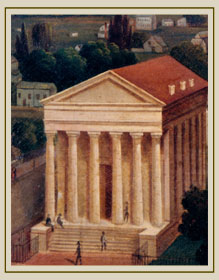
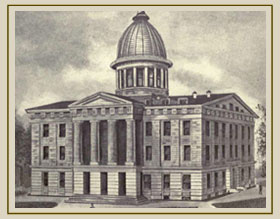
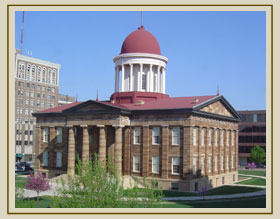
Shelby County Courthouse
On the third day of September, 1827, the Shelby County Commissioners met and determined
that they should have a new courthouse erected and the building was then constructed
near where the present court-house now stands. It was twenty feet wide by twenty-four
feet long. The first story rose nine feet, the second story five feet to the top of
wall-plate, and was in total roughly fourteen feet from the ground to the eaves of the
building; with a shingled roof. The main body of the structure was built of hewn logs,
with two doors below, two large windows with shutters, and two windows of the same
dimensions in the upper story, the upper part of the building being reached by a pair of
steps placed upon the outside. The floors of the two rooms were planked.
The contract was to be given to the lowest bidder, who was to undertake to have the
court-house completed on or before the first Monday in April, 1828. William Hall, Sr. was
paid $110 for the contract. Soon after, in the early part of 1829, considerable
improvements were added to the court-house,--the building itself was weatherboarded, and
the interior arrangements were improved for the benefit of the judge, lawyers, jurymen,
etc. These alterations were made by J. W. Johnston, and cost the county $39.25.
The second courthouse, made of brick, was erected in the centre of the public square at
Shelbyville in 1832. It was a two-story building, forty feet square, surmounted with a
dominant cupola, which was added in 1837. The first story between the floors was fourteen
feet tall, and the upper story rose to nine feet. The court-room occupied the entire
lower portion of the building and the offices above being reached by a double stairway on
the south side. The original cost of the building was $1094, but the cupola added an
additional $619. Another of this coffee-mill federal style, this new courthouse featured
10 windows on the first floor and 12 windows on the second. It was shingled in walnut or
oak and the second story was divided into three separate rooms by partitions, as needed and
two fireplaces.
In July of 1879, the county began building a newer courthouse, which stands proudly on the
grounds today, following completion in 1881.
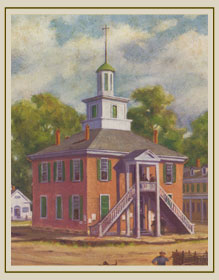
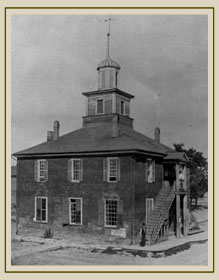
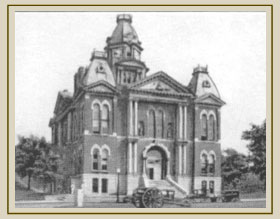
Tazewell County Courthouse
Mackinaw
In 1827 Mackinaw was surveyed and became a legal municipality, as well as the county
seat after Tazewell was formed out of Peoria County. A settler named Amasa Stout
constructed the first Tazewell County Court House for $125. The first jail of the
county was erected in Mackinaw at a cost of $325.75, and was one of the strongest
and most costly jails erected in Central Illinois at that time. Nevertheless, the
very first prisoner incarcerated within its heavy walls took flight the same night.
This individual, William Cowhart, is also noted for being the first horse thief in
Tazewell County. There is no image available for this courthouse.
Tremont
In 1836, the county seat was moved from Mackinaw to Tremont, where, that same year,
County Commissioners awarded a contract of $14,450 to William F. Flagg a man of some
local reknown. It was Flagg who had built the courthouses in LaSalle and Putnam
Counties before this task was awarded him. His design, completed in 1839, consisted
of a two-story, red-brick edifice sixty by forty feet in size, which included a
ten-foot-portico and a front pediment supported by four columns. The cupola contained
a bell that was covered by a copper dome. In 1850, the county seat was moved to Pekin
and the courthouse continued to be used by the locals for meetings until it fell into
disrepair and had to be demolished by the city in 1895.
Pekin
In 1850, Tazewell County's seat was moved to Pekin and a courthouse in the Grecian style
was erected shortly before the seat was moved and cost more than $8000. The portico
was supported by six columns on the front and was a stunning building. In 1914, however,
the courthouse was destroyed in order to clear the area for a newer courthouse and county
building.
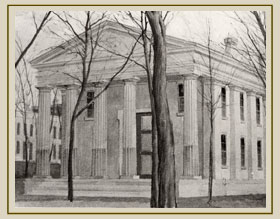
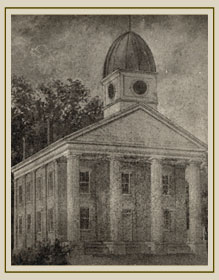
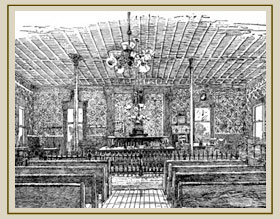
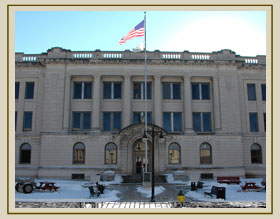
Vermilion County Courthouse
The first permanent courthouse in Danville, the county seat of Vermilion County,
was built by Thomas Durham in 1832. Another of the coffee-mill federal style, this
fifty-foot square building had its courtroom on the first floor and the jury rooms
divided on the second floor. The judge sat on his bench along the eastern wall and
the entrances to the building were on the southern and western sides of the courthouse.
At the time, the other county offices were elsewhere throughout the town, which was
more than slightly inconvenient, but there was just no room at the courthouse. The
offices for the clerks were added later in another wing that was added to the building.
A familiar figure in Danville between 1841 and 1859 was a gangling young country lawyer
named Abraham Lincoln.
After the building burned down in 1872, a new Vermilion County Courthouse was erected at
the same site. The cornerstone was laid in 1876, and the building was completed in 1877
at a cost of $104,550. The building was three stories high, and made of brick, stone and
iron. The shape of the courthouse was unique, the reason being that the county officials
wanted to make use of every available amount of space for county government.
By the turn of the century, it again became apparent that a larger courthouse was needed.
The major problem was money! At that time, the County Board of Supervisors had the authority
to "repair and remodel" the existing courthouse, but it could not construct a new building
without voter approval. It was widely assumed that the voters would not approve a new
courthouse. The existing one was only 34 years old.
In 1911, however, the County Board passed a resolution to "repair and remodel" the existing
courthouse. First, the cornerstone was moved to the northeast corner. Next, the entire
courthouse was demolished and rebuilt from the ground up. Official state records still show
that only two courthouses have ever stood on the Northeast Corner of the Public Square. Our
current building, which is our third courthouse, is officially described as a remodeled
version of the 1876 courthouse. The construction cost was slightly in excess of $250,000.
The "remodeled" courthouse was accepted as completed on December 11, 1913.
The Vermilion County Courthouse which is in use today stands at the Northeast corner of the
town square, as did its two predecessor courthouses. The current courthouse was last
extensively remodeled in 1988-1989 at a cost of five million dollars and was rededicated in
a 1990 ceremony by then-Circuit Judge, now Supreme Court Justice, Rita B. Garman.
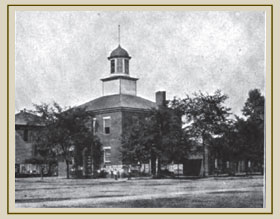
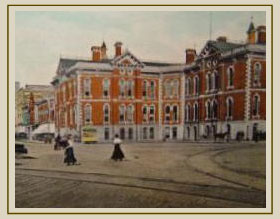
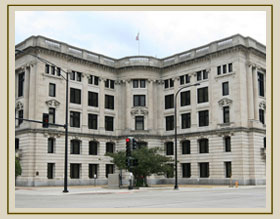
Woodford County Courthouse
In 1841, after being formed as a county, the small village of Versailles was the temporary
county seat and no known image exists of their temporary courthouse structure.
In 1843, the town of Hanover, whose name would later be changed to Metamora, was named as
the new seat for Woodford County and in 1845 construction was complete on the new courthouse
for a total cost of $4,400. This two-story, forty by fifty foot example of classic revival,
Greek styled temple architecture faces south towards the public square. It features four
chimneys that were fed from stoves within the building for heat and a set four four Ionic
pillars supporting the front portico. This brick structure is adorned by a wooden cupola
and housed three rooms separated by a central hallway on the first floor with an ascending
staircase to the second floor, which housed the lawyers rooms, the judge's chambers, and a
large open courtroom.
The Metamora courthouse continued its service until Woodford County voters moved the county
seat from Metamora to Eureka, Illinois in 1896. The historic former courthouse served as a
community center from 1896 until 1921; plays and movies were shown here, and community
organizations used the hall as a meeting place. Starting in 1921, the former courthouse was
restored as a local museum and memorial to the profession of law in early Illinois. The
building was added to the National Register of Historic Places in 1978. It is operated by the
Illinois Historic Preservation Agency.
Woodford County residents voted in 1894 to move the county seat to Eureka, Illinois and the
old county courthouse was deeded to the village of Metamora and has since been the site of
a number of local gatherings. In 1921, the State of Illinois assumed control of the old
courthouse and completely restored its appearance to be contemporary with how Lincoln would
have seen it. It is now a state historic site, administered by the Illinois Historic
Preservation Agency.
The Courthouse is one of only two Illinois circuit courthouses in which Lincoln practiced
law that are standing on their original foundations. The other is the Mount Pulaski Courthouse
State Historic Site. The Metamora Courthouse has two floors, with the first floor serving as a
museum of local history and Illinois frontier law, and the second floor restored to its 1850s
appearance as the county courtroom and adjacent judicial chambers.
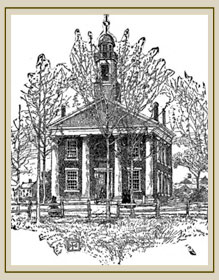
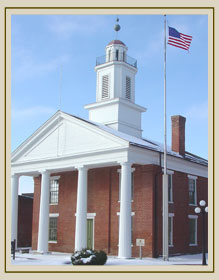
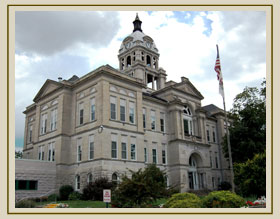
|






















































